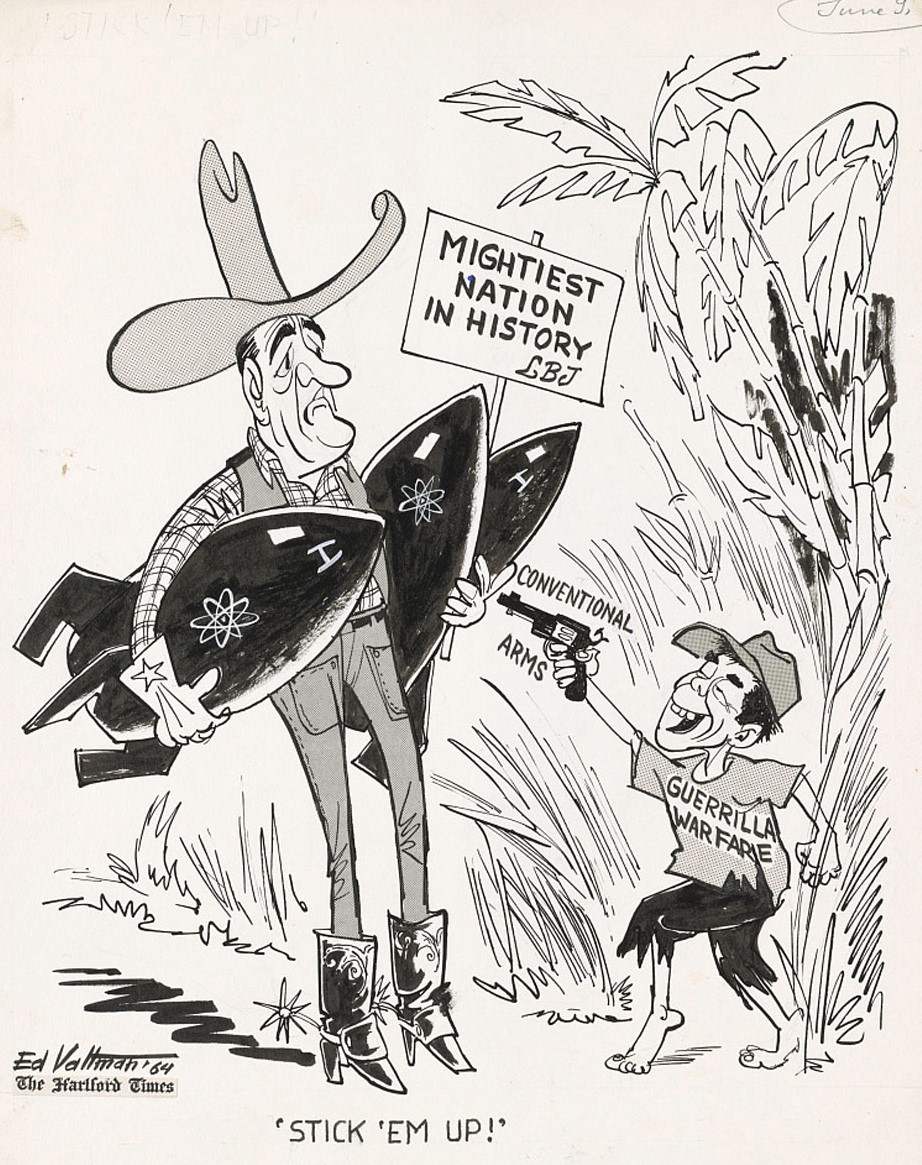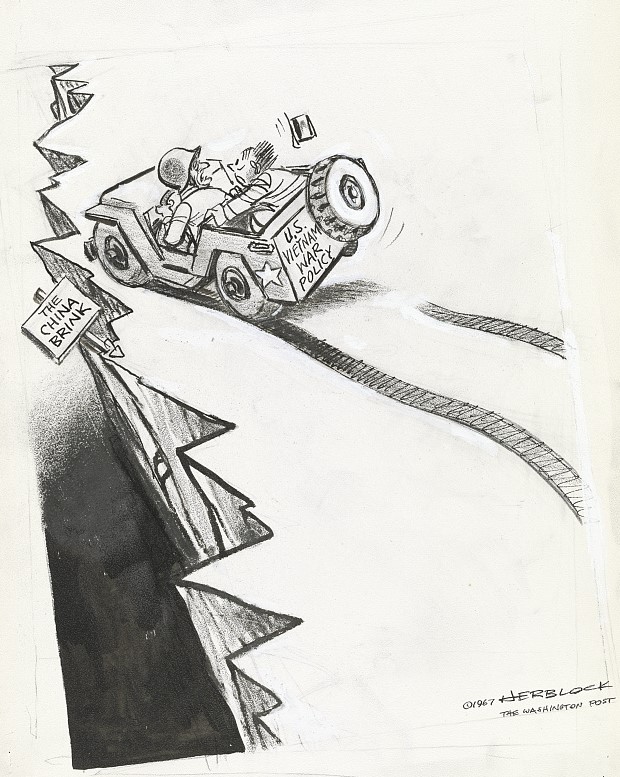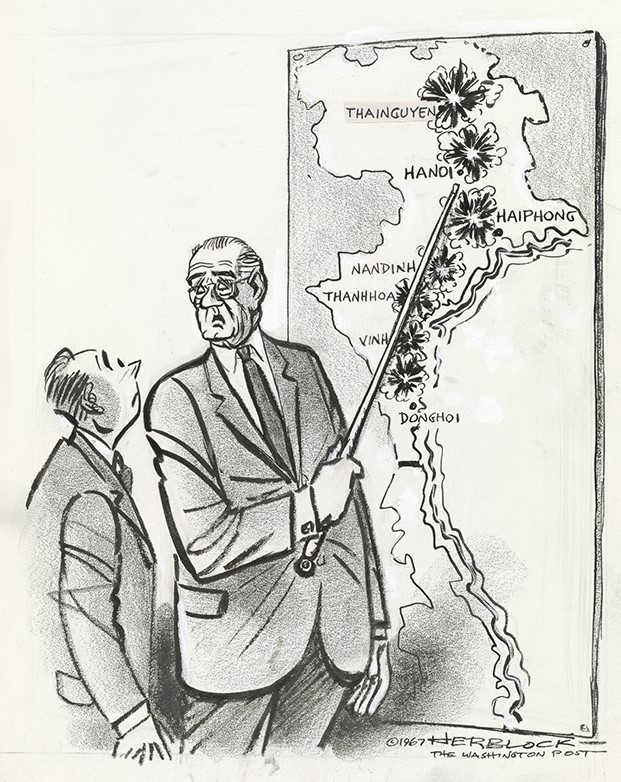Stick ’Em Up! (Valtman)
The 36th President of the USA, Lyndon B. Johnson, put a considerable amount of effort into holding back the intensification of the war in Vietnam. Before the election that was prepared to be held in 1964, his main aim was to avert the adverse consequences of wars impact on his ambitious domestic program. However, Edmund Valtman, the political cartoonist, had responded to it by presenting the nuclear armory of Johnson that was quickly destroyed by traditional weapons and guerrilla warfare, as shown on the cartoon (Valtman). Valtman disliked communism due to his experience with the Soviet Rule in his birthplace, Estonia.
Thus, he pictured Johnson in the negative and humorous appearance as a grown man with his so-called powerful nuclear arsenal, afraid of a small boy, a Viet Cong soldier, with conventional weapons. The cartoon presents Edmund Valtmans despise towards President Johnson, which is easy to understand from the picture.

What Escalation? We’re Just Moving Sideways (Herblock)
The USA was trying to control and simultaneously prevent the flow of supplies from China to Vietnam. Thus, the United States bombed the far north, near the boundary between the mentioned lands. President Lyndon Johnson had lifted limitations, enabling pilots to fly near the Chinese border. As a result, Herblock, the author of What Escalation? We’re Just Moving Sideways, pictured the cliff that falls into an unseen gap as a metaphor. It is clear that the stylistic device used by Herbert Block implies that Lyndon Johnson unwittingly is going in the direction that will sink the U.S. into even a more notable conflict because of his “U.S. Vietnam War Policy” (Herblock).

We’ve Shown That We’re Willing to Go More Than Half Way (Herblock)
Herbert L. Block used satire in this political cartoon in numerous ways, starting with the name of it, which is a quote of President Johnson, “We’ve Shown That We’re Willing to Go More Than Half Way” (Herblock). The picture demonstrates startling Lyndon Johnson, who states that he is planning on going “more than halfway” to set peace in negotiations with North Vietnam (Herblock).
Once again, the quote is implemented not only in the cartoon’s name but graphically on the map, which presents the northern part of Vietnam.

One can see that only the north part of Vietnam is bombed, which accumulates an approximate half of the country and serves as a satire towards the saying of “more than half way” (Herblock). The President had bombed North Vietnam with the aim of revenge because of The USA’s participation in guerrilla warfare in Laos. As a result, his attempts to achieve peace did not bring any fruitful results. On the contrary, the war only escalated, which can also be interpreted from the cartoon, We’ve Shown That We’re Willing to Go More Than Half Way by Herblock, in the form of a stick that is pointed upwards. Herblock’s shrewd implementation of satire enables one to understand the meaning of the cartoon easily, even without getting thoroughly familiar with the history of the Vietnam War.
The Cartoons Description about The Things They Carried by O’Brien
The cartoon based on How to Tell a True War Story highlights memories and sorrow rather than actual events in The Things They Carried (O’Brien). Therefore, the picture should be associated mainly with Curt Lemon’s sister, who receives a letter from his friend after her brother’s death. The cartoon should not contain any inclination regarding the occasion of Curts death since this story can be interpreted in different ways and cannot be called an actual war one this way (OBrien). In other words, the story written on the paper is trustworthy for Rat, Curts friend; however, Lemons sister finds it disturbing and inappropriate. As a result, the focus should be on the letter with the signature of Rat placed on the table torn in pieces.
The destruction of the letter should be connected with the grieve and sorrow of Curts sister and not the possible circumstances that led to the death of Curt Lemon. Moreover, there is a connection between the consequence of sending a letter and the plays with a grenade that, according to Rat, resulted in Curts death, “body parts strewn in the jungle trees” (O’Brien). Overall, Lemons sister assumes that the Rats story is entirely untruthful and destroys the memory of the letter the same way as Curt Lemon died due to the grenades explosion, according to his friend. Thus, the cartoon is focused on the outcomes of the story, the emotions and pain one feels after losing somebody, and not on the details of the death.
Works Cited
Herblock. (1967) “We’ve Shown That We’re Willing to Go More Than Half Way”. Published in the Washington Post. Library of Congress, Reproduction no. LC-DIG-hlb-06756.
Herblock (1967) “What Escalation? We’re Just Moving Sideways”. Published in the Washington Post. Library of Congress, Reproduction no. LC-DIG-hlb-06866.
O’Brien, T. (2015) “The Things They Carried.” How to Tell a True War Story. Fourth Estate, an Imprint of HarperCollins.
Valtman, E. (1964) “Stick ’Em Up!” Published in the Hartford Times. Library of Congress, Reproduction no. LC-DIG-ppmsca-38558.